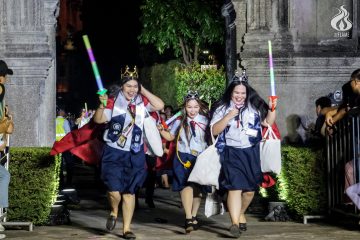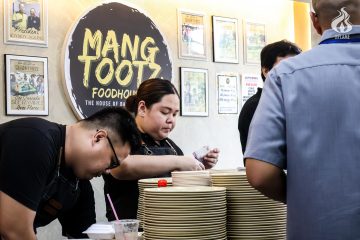By PAULINE JOYCE C. PASCUAL
NOTHING is more life-affirming than acquiring an appreciation for the arts, and the new normal is the season for trying out new experiences. Quarantine rules have eased, and Filipinos are eager to engage in activities that were previously halted during the pandemic’s peak.
Art Fair Philippines is no exception, as it resumed highlighting the best and brightest of the contemporary Philippine art scene.
The country’s premier exhibit, a promoter of the strength of modern and contemporary Philippine visual art, returned for its 10th edition with a hybrid experience from March 23 to April 1 that included physical exhibitions at Ayala Triangle Gardens and gallery venues, as well as online exhibitions and other activities at artfairphilippines.com.
One of the year’s highlights is the ArtFairPH/Projects area at the Ayala Tower One Fountain Area. In a remarkable display created in collaboration with art consultant Norman Crisologo and exhibition designer Ed Lacson, ten featured artists illustrate the “baroque quality” of the Philippine art scene.
Barok focuses on the purposely bizarre, the seemingly spontaneous, and the daringly experimental, all of which are infused with a distinct Filipino sensibility. It is trippy, fun, and young.
As Art Fair PH returned to its face-to-face grandeur and becomes a bustling hub of galleries and art discussions, The Flame features five of this year’s lineups to start your art appreciation journey as barok is back.
Playtime Paradiso by Tyang Karyel

Karyel represented a side of self that revels in pop culture’s fleeting pleasures.
Through installations, the artist synthesized numerous influences that reflect the world through euphoric candy colors.
It is created with various establishments that provide essential goods and services, such as toiletries, medicines, and key duplication. This is also a well-known part of the Filipino neighborhood.
Unknown Unknowns by Bjorn Calleja
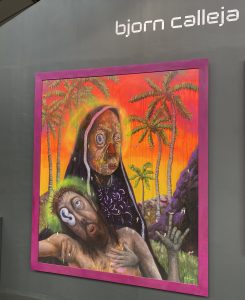
Calleja offered a glimpse into the endless potential of paintings as a medium. It revealed an imagination saturated with ideas of a globalized culture.
It flattened traditional hierarchies, tolerated impetuous markings on canvas, and embraces the allure of digital realities.
With their giant lips and googly eyes, the humanoid figures that remind one of Michelangelo’s ‘La Pieta’ symbolized the Sisyphean cycle that captures the endless human routine and time-related mutations.
Nakasalalay sa Lakas ng Dasal by Johanna Helmuth
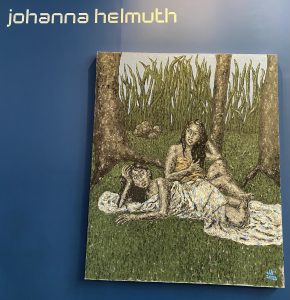
Helmuth’s work included paintings and sculptures, giving an atmosphere that conveyed both personal worship and nature’s healing tonic.
It gave a look into past lives and a vision of the future after the pandemic is over. This is exemplified through living without masks and picnicking on the grass without fear of infection.
The emphasis on female figures in Helmuth’s paintings reflected a strongly autobiographical element, bringing to light the interior lives of women at moments and situations when they are most themselves, away from the male gaze.
Mga Kuwento, Panaginip, at Panalangin by Ryan Jara
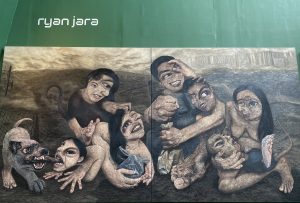
Jara portrayed his trademark motif within the background of the deadly pandemic in three large-scale pieces (basically murals) — Sa Bakod Ng Gusto at Kailangan, Sa Atin, Sa Akin, and Ang Liwanag Sa Kahon, Nakabalot Sa Dilim.
The artwork is painted in a monochromatic tone, showing characters trapped behind icy walls or against featureless landscapes, involved in a reality clamor and a mental battle.
The works have a mournful feel that emphasizes heights of sadness and disharmony painted on canvas.
Through cubism, it kept a metaphorical approach, expressing his characters in tense moods, often exposing a single eye, a dislocated mouth, and an overall frightening aspect.
Transcendence by Aze Ong
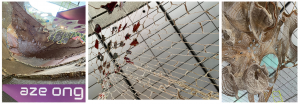
Fiber is Aze Ong’s primary weapon. Crocheting is her means of creation, which has traditional feminine connotations, but in the hands of the artist, changes into a malleable vehicle for spiritual rebirth.
Beginning with the iconic shape of the loop, the art has a strong influence on webs, and reacts to pandemic times through physical labor and spiritual contemplation.
All things in web relationships are reflected by Transcendence. It signified that all that has been lost has been transformed and is now alive somewhere.
Baroque has influenced not just mediums of art but also the works of contemporary artists. The use of baroque features, interplaying with the latter-day hallmarks, has recreated yet another reflection about the complexity of human life throughout history. F

